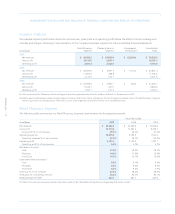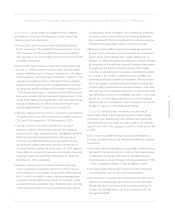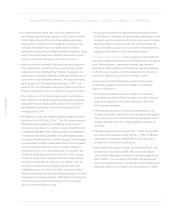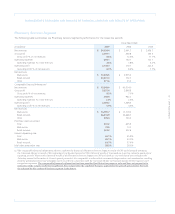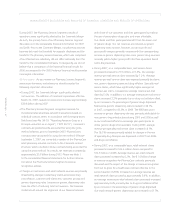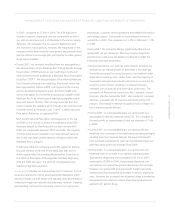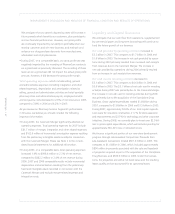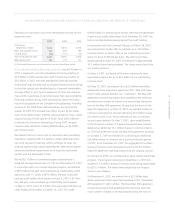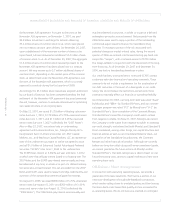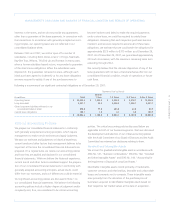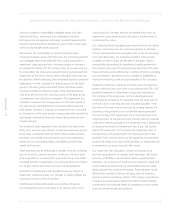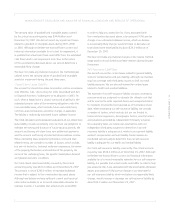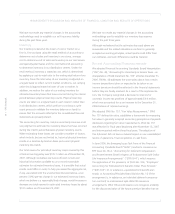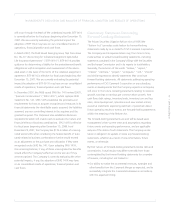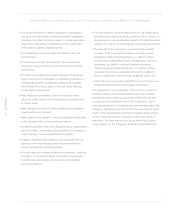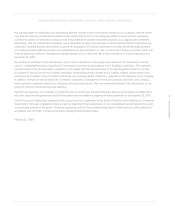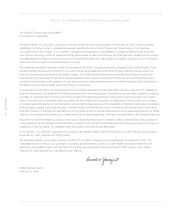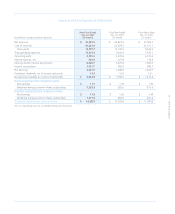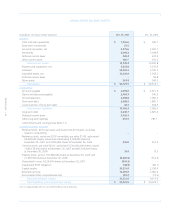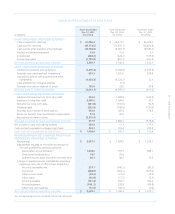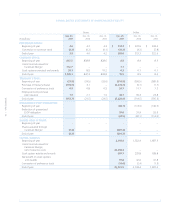CVS 2007 Annual Report Download - page 36
Download and view the complete annual report
Please find page 36 of the 2007 CVS annual report below. You can navigate through the pages in the report by either clicking on the pages listed below, or by using the keyword search tool below to find specific information within the annual report.
32 I CVS Caremark
Amounts assigned to identifiable intangible assets, and their
related useful lives, are derived from established valuation
techniques and management estimates. Goodwill represents the
excess of amounts paid for acquisitions over the fair market value
of the net identifiable assets acquired.
We evaluate the recoverability of certain long-lived assets,
including intangible assets with finite lives, but excluding goodwill
and intangible assets with indefinite lives, which are tested for
impairment using separate tests, whenever events or changes in
circumstances indicate that the carrying value of an asset may not
be recoverable. We group and evaluate these long-lived assets for
impairment at the lowest level at which individual cash flows can
be identified. When evaluating these long-lived assets for potential
impairment, we first compare the carrying amount of the asset
group to the asset group’s estimated future cash flows (undis-
counted and without interest charges). If the estimated future
cash flows are less than the carrying amount of the asset group,
an impairment loss calculation is prepared. The impairment loss
calculation compares the carrying amount of the asset group to
the asset group’s estimated future cash flows (discounted and
with interest charges). If required, an impairment loss is recorded
for the portion of the asset group’s carrying value that exceeds the
asset group’s estimated future cash flows (discounted and with
interest charges).
Our long-lived asset impairment loss calculation contains uncer-
tainty since we must use judgment to estimate each asset group’s
future sales, profitability and cash flows. When preparing these
estimates, we consider historical results and current operating
trends and our consolidated sales, profitability and cash flow
results and forecasts.
These estimates can be affected by a number of factors including,
but not limited to, general economic conditions, efforts of third
party organizations to reduce their prescription drug costs and/or
increased member co-payments, the continued efforts of competi-
tors to gain market share and consumer spending patterns.
Goodwill and indefinitely-lived intangible assets are subject to
impairment reviews annually, or if changes or events indicate the
carrying value may not be recoverable.
Indefinitely-lived intangible assets are tested by comparing
the estimated fair value of the asset to its carrying value. If the
carrying value of the asset exceeds its estimated fair value, an
impairment loss is recognized and the asset is written down to
its estimated fair value.
Our indefinitely-lived intangible asset impairment loss calculation
contains uncertainty since we must use judgment to estimate
the fair value based on the assumption that in lieu of ownership
of an intangible asset, the Company would be willing to pay
a royalty in order to utilize the benefits of the asset. Value is
estimated by discounting the hypothetical royalty payments to
their present value over the estimated economic life of the asset.
These estimates can be affected by a number of factors including,
but not limited to, general economic conditions, availability of
market information as well as the profitability of the Company.
Goodwill is tested on a reporting unit basis using the expected
present value of future cash flows. In accordance with SFAS 142,
goodwill impairment is determined using a two-step process.
The first step of the impairment test is to identify potential
impairment by comparing the reporting unit’s fair value with its
net book value (or carrying amount), including goodwill. If the
fair value of the reporting unit exceeds its carrying amount, the
reporting unit’s goodwill is not considered to be impaired and
the second step of the impairment test is not performed. If the
carrying amount of the reporting unit’s carrying amount exceeds
its fair value, the second step of the impairment test is performed
to measure the amount of impairment loss, if any. The second
step of the impairment test compares the implied fair value of
the reporting unit’s goodwill with the carrying amount of the
goodwill. If the carrying amount of the reporting unit’s goodwill
exceeds the implied fair value of the goodwill, an impairment loss
is recognized in an amount equal to that excess.
Our impairment loss calculation contains uncertainty since
we must use judgment to estimate each reporting unit’s future
revenues, profitability and cash flows. When preparing these
estimates, we consider each reporting unit’s historical results and
current operating trends and our consolidated revenues, profit-
ability and cash flow results and forecasts. These estimates can be
affected by a number of factors including, but not limited to,
general economic conditions, efforts of third party organizations
to reduce their prescription drug costs and/or increase member
co-payments, the continued efforts of competitors to gain market
share and consumer spending patterns.


